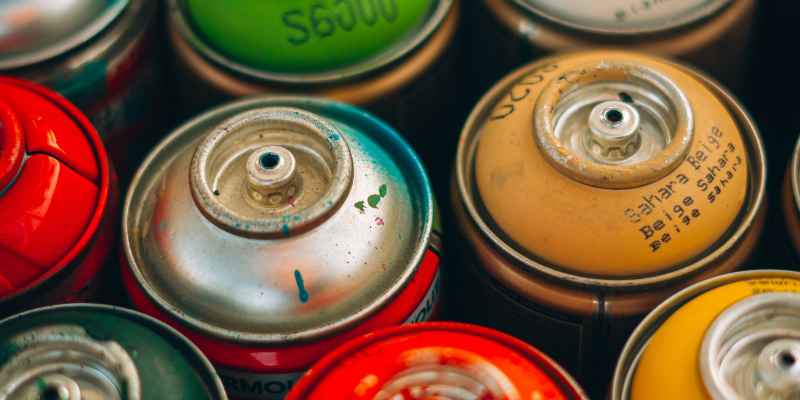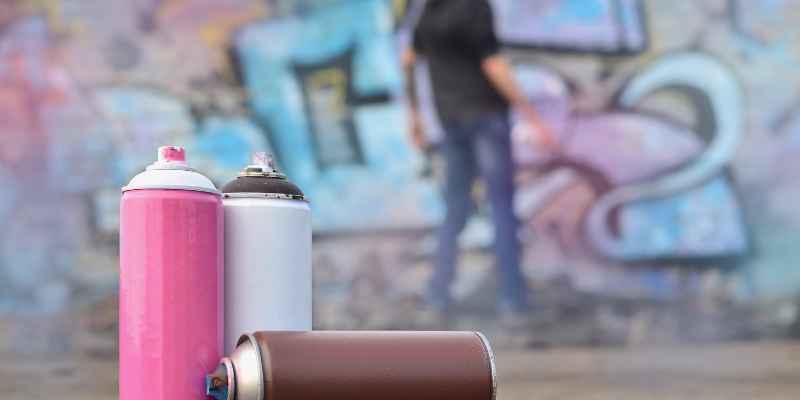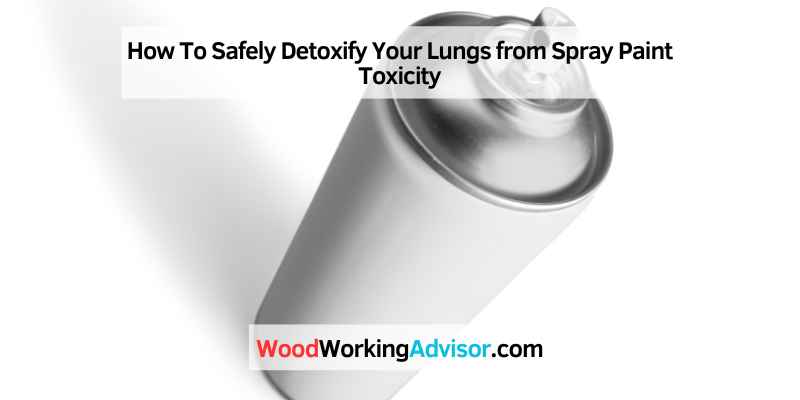To clear lungs of spray paint, stay in a well-ventilated area and engage in deep breathing exercises. Use a respiratory mask when handling spray paint and seek medical attention if experiencing respiratory distress.
Find more information and tips below. Spray paint is a commonly used product for various purposes, such as painting walls, furniture, and artworks. While it can transform objects into vibrant masterpieces, the fumes emitted during its application can be harmful when inhaled.
The toxic chemicals present in spray paint can irritate the respiratory system, causing difficulty in breathing and other respiratory issues. Therefore, it is crucial to know how to clear lungs of spray paint to minimize any potential health risks. We will provide you with some effective steps to protect your lungs and clear them of any spray paint residue. By following these guidelines, you can ensure a safer and healthier environment for yourself and those around you.
Understanding Spray Paint Toxicity
Spray paint is a commonly used method of adding color and vibrancy to various surfaces. While it may seem like a convenient choice for quick and effective painting, it is important to understand the potential risks associated with spray paint toxicity. By being aware of the common health risks and the effects on the lungs, you can take the necessary steps to clear your lungs of spray paint and protect your respiratory health.
Common Health Risks
Spray paint contains various chemicals that can be harmful if inhaled or absorbed through the skin. Some of the common chemicals found in spray paint include acetone, toluene, xylene, and formaldehyde. Exposure to these chemicals can lead to a range of health risks, including:
- Eye irritation and vision problems
- Nausea, dizziness, and headaches
- Allergic reactions and skin irritation
- Respiratory issues, such as coughing, wheezing, and difficulty breathing
- Nervous system disorders
While these health risks may vary depending on the individual’s sensitivity and the amount of exposure, it is important to be cautious when using spray paint.
Effects On Lungs
When it comes to spray paint toxicity, the lungs are particularly vulnerable due to the inhalation of harmful fumes and particles. The effects of spray paint on the lungs can range from short-term irritation to long-term damage. Some of the potential effects include:
- Lung irritation and inflammation, leading to coughing and shortness of breath
- Development of respiratory conditions, such as asthma or bronchitis
- Inhalation of toxic chemicals, which can damage the tissues and cells in the lungs
- Potential risk of developing lung cancer, particularly with prolonged and excessive exposure
Considering the health risks and effects on the lungs, it is essential to take proactive measures to clear your lungs of spray paint and minimize the potential harm.
Importance Of Lung Detoxification
Lung detoxification is crucial when it comes to clearing your lungs from spray paint particles. Take effective steps to cleanse your lungs and breathe in fresh air for better respiratory health.
Reducing Toxic Buildup
When it comes to spray paint exposure, our lungs can suffer from the toxic chemicals present in the paint. The buildup of these toxins can have detrimental effects on our respiratory system and overall health. That’s why it is crucial to prioritize lung detoxification and remove these harmful substances from our bodies.
Reducing toxic buildup in the lungs involves implementing certain strategies that can effectively cleanse the respiratory system. This process can help alleviate symptoms such as coughing, wheezing, and shortness of breath, while also preventing long-term lung damage.
Here are some methods to reduce toxic buildup in the lungs:
- Quit smoking: If you smoke, quitting is the most essential step in reducing toxic buildup in the lungs. Smoking not only introduces harmful chemicals into the lungs but also damages the delicate lung tissues. By quitting smoking, you give your lungs a chance to heal and regain their natural detoxifying abilities.
- Avoid exposure to pollutants: Minimize your exposure to pollutants such as airborne chemicals, smoke, and industrial fumes. These pollutants can further burden your lungs and hinder their natural detoxification process. Use masks or respirators in environments where these pollutants are present.
- Eat antioxidant-rich foods: Antioxidants help protect cells from damage caused by free radicals, which can arise from exposure to toxins. Include foods like berries, leafy green vegetables, citrus fruits, and nuts in your diet to boost your antioxidant intake and support lung health.
Enhancing Respiratory Function
In addition to reducing toxic buildup, enhancing respiratory function is vital for improving lung health and clearing spray paint from the lungs. By optimizing your respiratory system, you can effectively expel toxins and promote better breathing.
Here are some practices to enhance respiratory function:
- Practice deep breathing exercises: Deep breathing exercises help expand lung capacity and increase oxygen intake. This can assist in expelling toxins and improving overall lung function. Take slow, deep breaths in and out, focusing on filling your lungs fully and exhaling completely.
- Engage in regular physical activity: Physical activity helps strengthen your respiratory muscles, making them more efficient in clearing toxins from the lungs. Aim for at least 30 minutes of moderate aerobic exercise, such as brisk walking or cycling, on most days of the week.
- Maintain good indoor air quality: Ensure proper ventilation in your living space to minimize the accumulation of indoor air pollutants. Use air purifiers and keep windows open when weather permits to allow fresh air circulation. Regularly clean and dust your home to reduce allergens.
By focusing on reducing toxic buildup and enhancing respiratory function, you can effectively clear your lungs of spray paint and promote better lung health. Incorporate these strategies into your lifestyle to support your body’s natural detoxification process and ensure long-term well-being.

Natural Methods For Lungs Detoxification
Detoxifying your lungs after exposure to spray paint is crucial for maintaining optimal respiratory health. While there are several methods available, natural approaches offer a gentle yet effective way to clear out harmful toxins. Incorporating these natural techniques into your routine can help rejuvenate your lungs.
1. Deep Breathing Exercises
Deep breathing exercises can help expand the lung capacity and improve circulation. Start by finding a quiet and comfortable place to sit or lie down. Close your eyes and take slow, deep breaths in and out, filling your lungs completely. Hold your breath for a few seconds before exhaling slowly. Repeat this exercise for several minutes each day to cleanse your lungs.
2. Hydration
Staying hydrated is essential for lung detoxification. Drinking plenty of water helps flush out toxins and keeps your respiratory tract moist. Aim to consume at least 8-10 glasses of water each day. You can also incorporate herbal teas or warm lemon water into your routine to further support lung cleansing.
3. Antioxidant-rich Diet
Consuming an antioxidant-rich diet can provide your lungs with the necessary nutrients to repair and detoxify. Include foods such as berries, leafy greens, citrus fruits, and nuts in your meals. These foods are packed with vitamins, minerals, and antioxidants that help fight off free radicals and promote lung health.
4. Herbal Remedies
Certain herbs can help soothe and heal the respiratory system. Mullein, licorice root, and eucalyptus are known for their natural anti-inflammatory and expectorant properties. You can consume these herbs as teas, tinctures, or extracts to assist in clearing your lungs of toxic residue.
5. Regular Exercise
Engaging in regular exercise is vital for overall health and can contribute to lung detoxification. Physical activity promotes increased oxygen flow and improves lung capacity. Incorporate activities such as walking, jogging, cycling, or swimming into your routine to enhance lung function and expel toxins.
Avoiding Future Toxicity
Once you have successfully cleared your lungs of spray paint fumes, it’s vital to take preventive measures to avoid future toxicity. By minimizing exposure, using protective gear, and improving indoor air quality, you can significantly reduce the risk of harmful health effects. Let’s explore these strategies in more detail.
Minimizing Exposure
Minimizing exposure to spray paint chemicals is crucial to long-term lung health. Here are some simple yet effective ways to achieve this:
- Avoid working in areas with poor ventilation, as this can cause the accumulation of toxic fumes.
- If possible, choose open-air or outdoor spaces when spray painting to allow for better air circulation.
- Work during times when the area is less crowded, reducing the risk of inhaling other people’s fumes.
- Consider using water-based or low-VOC (volatile organic compounds) spray paints, as they produce fewer toxic emissions.
- Dispose of empty spray paint cans properly, following local regulations, to prevent environmental contamination.
Using Protective Gear
Protective gear is your first line of defense against spray paint fumes. Equip yourself with the following items to keep your lungs safe:
- Wear a respirator or a mask specifically designed for spray painting to filter out harmful chemicals.
- Choose gloves that are resistant to solvents and chemicals to protect your skin from direct contact.
- Wear long-sleeved clothing and pants to minimize skin exposure to spray paint.
- Consider wearing safety goggles to shield your eyes from paint particles and potential splatters.
- Do not neglect the importance of proper footwear, as it prevents accidental exposure to paint through your feet.
Improving Indoor Air Quality
Improving indoor air quality is essential, not only for respiratory health but also for overall well-being. Take the following steps to reduce spray paint-related toxins inside your home or workspace:
- Open windows and doors to promote air circulation and ventilation, allowing fresh air to replace any polluted air.
- Consider using air purifiers or installing ventilation systems to remove toxins from the air.
- Regularly clean and dust your surroundings to prevent the accumulation of paint particles.
- Avoid smoking indoors, as it can worsen the air quality and increase the risk of respiratory issues.
- Keep indoor plants, as they naturally filter the air and improve its quality.
Seeking Professional Help
If you are trying to clear your lungs of spray paint or any other contaminants and are unsure about the best approach, it may be time to seek professional help. Consulting a doctor can provide valuable guidance and ensure that you receive the appropriate medical treatments for lung detoxification. In this section, we will discuss when to consult a doctor and the various medical treatments available for clearing your lungs.
When To Consult A Doctor
If you are experiencing persistent or worsening respiratory symptoms after being exposed to spray paint, it is crucial to consult a doctor. While some temporary irritation and coughing can be expected, prolonged or severe symptoms may indicate a more serious problem. Here are some signs that should prompt you to seek medical attention:
- Difficulty breathing or shortness of breath
- Chest pain or tightness
- Coughing up blood
- Wheezing or noisy breathing
- Extreme fatigue or weakness
Remember that everyone’s tolerance to spray paint fumes can vary, so it is essential to listen to your body and recognize when a trip to the doctor is warranted.

Medical Treatments For Lung Detoxification
It is essential to note that the information provided here is general advice and should not replace professional medical consultation.
When seeking medical treatments for lung detoxification, your doctor may recommend various approaches based on your specific condition and symptoms. Some common medical treatments for clearing the lungs include:
- Bronchodilators: These medications help relax and open the airways, making it easier to breathe. They can reduce bronchospasm and relieve symptoms like wheezing and shortness of breath.
- Corticosteroids: These anti-inflammatory medications can help reduce lung inflammation and control symptoms like coughing and wheezing.
- Cough Medicine: In some cases, your doctor may prescribe cough medicine to alleviate persistent coughing and help clear mucus from the lungs.
- Oxygen Therapy: For severe cases, oxygen therapy may be necessary to ensure you receive an adequate supply of oxygen. This treatment involves using a device to deliver concentrated oxygen directly to your lungs.
- Pulmonary Rehabilitation: Your doctor may refer you to a pulmonary rehabilitation program that includes a combination of physical exercise, education, and support to improve lung function and overall respiratory health.
- Antibiotics: If a respiratory infection develops due to exposure to paint fumes, your doctor may prescribe antibiotics to treat the infection.
It is crucial to follow your doctor’s advice and complete any prescribed treatments to ensure a proper recovery and minimize the risk of long-term lung damage. Your doctor will guide you through the process and monitor your progress along the way.
Conclusion
Keeping our lungs clear of spray paint is crucial for our overall health. By following the steps outlined in this blog post, you can effectively ensure that you are taking the necessary precautions to protect your lungs from harmful toxins.
Remember to use proper ventilation, wear protective gear, and limit your exposure to spray paint fumes. Your lungs will thank you for it. Stay safe and breathe easy!


